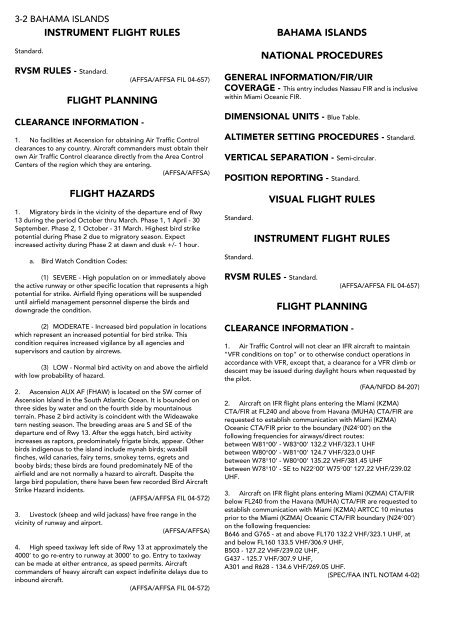NORTH AND SOUTH AMERICA - CNATRA - The US Navy
NORTH AND SOUTH AMERICA - CNATRA - The US Navy
NORTH AND SOUTH AMERICA - CNATRA - The US Navy
You also want an ePaper? Increase the reach of your titles
YUMPU automatically turns print PDFs into web optimized ePapers that Google loves.
3-2 BAHAMA ISL<strong>AND</strong>S<br />
INSTRUMENT FLIGHT RULES<br />
Standard.<br />
RVSM RULES - Standard.<br />
FLIGHT PLANNING<br />
CLEARANCE INFORMATION -<br />
(AFFSA/AFFSA FIL 04-657)<br />
1. No facilities at Ascension for obtaining Air Traffic Control<br />
clearances to any country. Aircraft commanders must obtain their<br />
own Air Traffic Control clearance directly from the Area Control<br />
Centers of the region which they are entering.<br />
(AFFSA/AFFSA)<br />
FLIGHT HAZARDS<br />
1. Migratory birds in the vicinity of the departure end of Rwy<br />
13 during the period October thru March. Phase 1, 1 April - 30<br />
September. Phase 2, 1 October - 31 March. Highest bird strike<br />
potential during Phase 2 due to migratory season. Expect<br />
increased activity during Phase 2 at dawn and dusk +/- 1 hour.<br />
a. Bird Watch Condition Codes:<br />
(1) SEVERE - High population on or immediately above<br />
the active runway or other specific location that represents a high<br />
potential for strike. Airfield flying operations will be suspended<br />
until airfield management personnel disperse the birds and<br />
downgrade the condition.<br />
(2) MODERATE - Increased bird population in locations<br />
which represent an increased potential for bird strike. This<br />
condition requires increased vigilance by all agencies and<br />
supervisors and caution by aircrews.<br />
(3) LOW - Normal bird activity on and above the airfield<br />
with low probability of hazard.<br />
2. Ascension AUX AF (FHAW) is located on the SW corner of<br />
Ascension Island in the South Atlantic Ocean. It is bounded on<br />
three sides by water and on the fourth side by mountainous<br />
terrain. Phase 2 bird activity is coincident with the Wideawake<br />
tern nesting season. <strong>The</strong> breeding areas are S and SE of the<br />
departure end of Rwy 13. After the eggs hatch, bird activity<br />
increases as raptors, predominately frigate birds, appear. Other<br />
birds indigenous to the island include mynah birds; waxbill<br />
finches, wild canaries, fairy terns, smokey terns, egrets and<br />
booby birds; these birds are found predominately NE of the<br />
airfield and are not normally a hazard to aircraft. Despite the<br />
large bird population, there have been few recorded Bird Aircraft<br />
Strike Hazard incidents.<br />
(AFFSA/AFFSA FIL 04-572)<br />
3. Livestock (sheep and wild jackass) have free range in the<br />
vicinity of runway and airport.<br />
(AFFSA/AFFSA)<br />
4. High speed taxiway left side of Rwy 13 at approximately the<br />
4000’ to go re-entry to runway at 3000’ to go. Entry to taxiway<br />
can be made at either entrance, as speed permits. Aircraft<br />
commanders of heavy aircraft can expect indefinite delays due to<br />
inbound aircraft.<br />
(AFFSA/AFFSA FIL 04-572)<br />
BAHAMA ISL<strong>AND</strong>S<br />
NATIONAL PROCEDURES<br />
GENERAL INFORMATION/FIR/UIR<br />
COVERAGE - This entry includes Nassau FIR and is inclusive<br />
within Miami Oceanic FIR.<br />
DIMENSIONAL UNITS - Blue Table.<br />
ALTIMETER SETTING PROCEDURES - Standard.<br />
VERTICAL SEPARATION - Semi-circular.<br />
POSITION REPORTING - Standard.<br />
Standard.<br />
Standard.<br />
VISUAL FLIGHT RULES<br />
INSTRUMENT FLIGHT RULES<br />
RVSM RULES - Standard.<br />
FLIGHT PLANNING<br />
CLEARANCE INFORMATION -<br />
(AFFSA/AFFSA FIL 04-657)<br />
1. Air Traffic Control will not clear an IFR aircraft to maintain<br />
"VFR conditions on top" or to otherwise conduct operations in<br />
accordance with VFR, except that, a clearance for a VFR climb or<br />
descent may be issued during daylight hours when requested by<br />
the pilot.<br />
(FAA/NFDD 84-207)<br />
2. Aircraft on IFR flight plans entering the Miami (KZMA)<br />
CTA/FIR at FL240 and above from Havana (MUHA) CTA/FIR are<br />
requested to establish communication with Miami (KZMA)<br />
Oceanic CTA/FIR prior to the boundary (N24°00’) on the<br />
following frequencies for airways/direct routes:<br />
between W81°00’ - W83°00’ 132.2 VHF/323.1 UHF<br />
between W80°00’ - W81°00’ 124.7 VHF/323.0 UHF<br />
between W78°10’ - W80°00’ 135.22 VHF/381.45 UHF<br />
between W78°10’ - SE to N22°00’ W75°00’ 127.22 VHF/239.02<br />
UHF.<br />
3. Aircraft on IFR flight plans entering Miami (KZMA) CTA/FIR<br />
below FL240 from the Havana (MUHA) CTA/FIR are requested to<br />
establish communication with Miami (KZMA) ARTCC 10 minutes<br />
prior to the Miami (KZMA) Oceanic CTA/FIR boundary (N24°00’)<br />
on the following frequencies:<br />
B646 and G765 - at and above FL170 132.2 VHF/323.1 UHF, at<br />
and below FL160 133.5 VHF/306.9 UHF,<br />
B503 - 127.22 VHF/239.02 UHF,<br />
G437 - 125.7 VHF/307.9 UHF,<br />
A301 and R628 - 134.6 VHF/269.05 UHF.<br />
(SPEC/FAA INTL NOTAM 4-02)

















